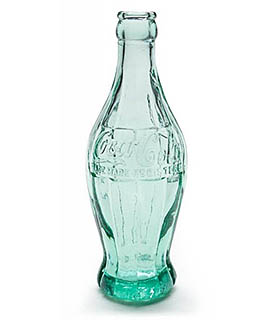Even though aluminum cans and plastic bottles predominate, there's something about an ice-cold Coca-Cola served in its signature voluptous glass bottle that never fails to impress. The thick glass, shaped to perfectly fit into the hand and with raised lettering, telegraphs ripeness in its organic hourglass form. The patent for this design was issued on November 16, 1915, making today the centennial of this celebrated product packaging that is known around the world. The original design is referenced today in a variety of packaging materials for the world's best-selling soft drink. But it is in the greenish glass blottle that the form is most powerful, providing a visual and tactile sensuality that retains its power despite the proliferation of sophisticated package design in the century since. The story of how this quintessential design came to be is little-known and quite amusing.
 Industrial bottle mold supervisor and sometime designer Earl R. Dean responded to a 1915 competition announced by the Coca-Cola Company, which realized it needed an iconic bottle to set it apart from the many competitors chasing the success of the beverage launched in 1886. According to Wikipedia, the call for entries was explicit in what was sought: "a bottle which a person could recognize even if they felt it in the dark, and so shaped that, even if broken, a person could tell at a glance what it was." Dean's boss, the president of the Root Glass Company in Terre Haute, Indiana, wanted to design a bottle based on the shape of Coca-Cola's signature ingredients — coca leaves and kola nuts, but nobody knew what these exotic plants actually looked like. A reference-material run to the local library by Dean and a co-worker was unsuccessful, but the designer was transfixed by an image of a ripe cocoa-pod, which he sketched and proposed basing a bottle design with a swollen mid-section, larger than the base.
Industrial bottle mold supervisor and sometime designer Earl R. Dean responded to a 1915 competition announced by the Coca-Cola Company, which realized it needed an iconic bottle to set it apart from the many competitors chasing the success of the beverage launched in 1886. According to Wikipedia, the call for entries was explicit in what was sought: "a bottle which a person could recognize even if they felt it in the dark, and so shaped that, even if broken, a person could tell at a glance what it was." Dean's boss, the president of the Root Glass Company in Terre Haute, Indiana, wanted to design a bottle based on the shape of Coca-Cola's signature ingredients — coca leaves and kola nuts, but nobody knew what these exotic plants actually looked like. A reference-material run to the local library by Dean and a co-worker was unsuccessful, but the designer was transfixed by an image of a ripe cocoa-pod, which he sketched and proposed basing a bottle design with a swollen mid-section, larger than the base.
 After getting the green-light from his boss at the bottling company, Dean created a mold and produced a number of glass prototypes, which were patented 100 years ago today. Problems quickly came to light — the bottle, wider at the middle than the base, tipped over too easily and didn't fit easily into cases for bottle distribution. A slimmed-down version was brought to a 1916 gathering of Coca-Cola bottlers from around the U.S., where it was voted as the best of several proffered designs. By 1920, the "countour bottle" had been adopted as the company's standard, which it has remained with minor tweaks in the decades since.
After getting the green-light from his boss at the bottling company, Dean created a mold and produced a number of glass prototypes, which were patented 100 years ago today. Problems quickly came to light — the bottle, wider at the middle than the base, tipped over too easily and didn't fit easily into cases for bottle distribution. A slimmed-down version was brought to a 1916 gathering of Coca-Cola bottlers from around the U.S., where it was voted as the best of several proffered designs. By 1920, the "countour bottle" had been adopted as the company's standard, which it has remained with minor tweaks in the decades since.
A recent exhibition celebrating the bottle design at the High Museum in Atlanta, provides further details about the history, as well as additional images.


